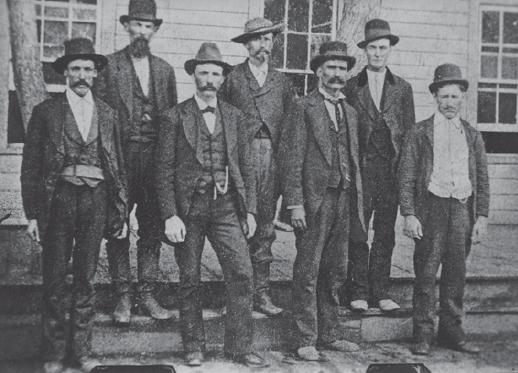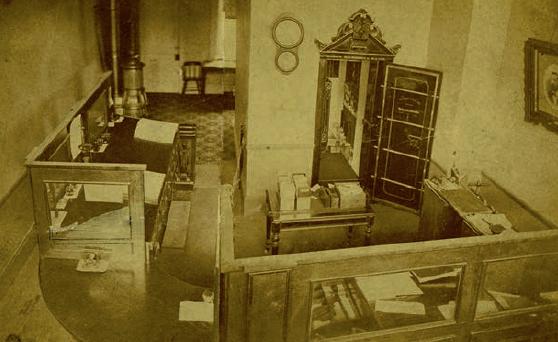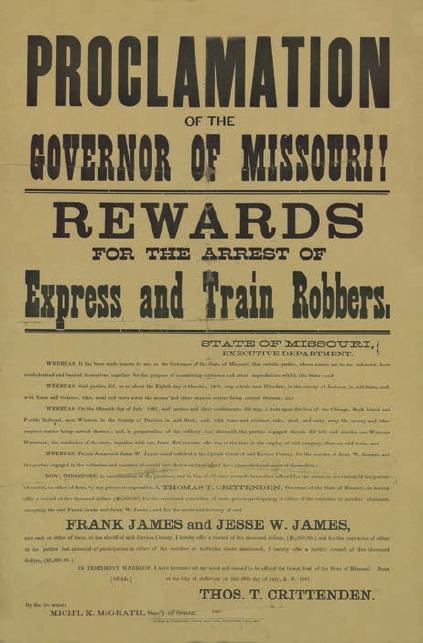Bill O'Reilly's Legends and Lies (33 page)
Read Bill O'Reilly's Legends and Lies Online
Authors: David Fisher

A magazine illustration showing Frank and Jesse James holding up the Chicago & Alton Railroad in 1879—escaping with six thousand dollars
The gang followed no discernible pattern and stayed on the move. Its reputation continued to grow throughout the country, but especially throughout the former Confederacy, where sympathizers helped the men evade the law. At times they lived a reasonably normal life, at least for robbers and killers. Within months of each other early in 1874, for example, both Jesse and Frank married and set up households.
Their fame was such that almost every crime in the region initially was attributed to them. Jesse’s audacious scheme of leaving notes at robberies helped the newspapers create his populist image. Some Southern newspapers began to portray him in almost heroic terms, repeating the completely untrue claim that he robbed from the rich and gave to the poor. In actuality, the gang robbed from pretty much everybody, and kept all of it.
In March 1874, Pinkerton operative Joseph Whicher arrived in Clay County, intending to go out to the James farm disguised as a fugitive from justice and confront Jesse and Frank.
One day later, his body was discovered with three bullet holes in it. By the time the body was found, the pigs had gotten to it. At just about the same time, three Pinkertons went to St. Clair County, Missouri, to deal with the Youngers. In a shoot-out, John Younger and two of the Pinks were killed.
For reasons obvious and personal, the founder of Pinkerton’s, Allan Pinkerton, responded harshly to the murder of his three men. On the night of January 25, 1875, as Reuben and Zerelda Samuel and their nine-year-old son, Archie, slept, Pinks silently surrounded the farmhouse. One of them hurled an incendiary device through the window. Reuben found a shovel and pushed it into the fireplace—and seconds later it exploded. Zerelda’s arm was so badly ripped apart that it had to be amputated; shrapnel tore into Archie Samuel’s body and killed him. Eight Pinks were indicted for murder, although none was ever tried for the crime. The Pinkertons, facing the unenviable task of pursuing popular criminals living in an environment supportive of them and hostile to the detectives, dropped the case. The gang had defeated the best law-enforcement agency in the country.
John Edwards used his editorial pages to raise both fury at the carpetbaggers and sympathy for the people who fought them, causing the Missouri legislature to propose a bill granting amnesty to the James-Younger Gang. But when Daniel Askew, a local farmer who was believed to have helped the Pinkertons plan their raid, was murdered on April 12, that offer was rescinded.

After the disastrous attempt to rob the Northfield, Minnesota, bank, this posse pursued the three Younger brothers for almost three weeks before capturing them in a swamp.
It’s doubtful Jesse would have accepted it, anyway. The killing of his half brother and maiming of his mother pushed Jesse James far beyond any possibility of redemption. His only purpose in life was to punish the North. To build support, Jesse routinely wrote letters to newspapers, claiming as he did in the
Nashville Banner,
“[F]or 10 years the radical papers in Mo. and other states have charged nearly every daring robbery in America to the James and Youngers. It is enough persecution for the northern papers to persecute us without the papers in the south persecuting us, the land we fought for four years to save from northern tyranny …” In a postscript to this letter, the obviously proud James asks that a copy of it be sent to his mother in Clay County.
Perhaps believing the tales that made it appear invincible, the gang made the fatal decision to move north for its next caper, far from the friendly surroundings that provided cover for it. The men chose the First National Bank of Northfield, Minnesota, supposedly because of its connection to two Union generals, Benjamin Butler and Adelbert Ames. Ames was believed to have recently made a fifty-thousand-dollar deposit. They planned the job for weeks but failed to take into account the very different environment in Minnesota. Northfield was a small town of hardworking, tough people and farmers who dressed plainly, and the only weapons they carried were long guns. Many of the residents had seen action with the First Minnesota during the war. From the moment the robbers rode into town, dressed in linen dusters and carrying pistols, they attracted suspicion. Three members of the gang went into the bank, while five men waited outside, several of whom began riding up and down Division Street, firing their weapons into the air, attempting to scare people off the streets.

The First National Bank of Northfield, Minnesota, was the last robbery of the infamous James-Younger Gang. Every gang member was wounded, two of them were killed, and the three Younger brothers were captured—for bags of nickels.
These people didn’t scare easily. Instead, one man peered into the bank through a window and began shouting, “They’re robbing the bank, boys! Go get your guns!”
The robbery went wrong from the beginning. When a cashier refused to open the safe, he was killed. Rather than the fifty thousand, the gang found only bags of nickels worth about twenty-three dollars. Townspeople reached for their guns and started firing while the robbers were still inside the bank. The
Sunday Times
of Chicago praised them: “The robbers did not get into the vault, nor did they find the cashier’s drawer, except the nickel drawer, and the handful of nickels taken from it was thrown to the floor. The citizens of Northfield behaved like old veterans, as many of them are.” The proprietor of the local hardware store initially believed the robbery was a promotional stunt for a local theater company, but when he realized it was for real, he picked up a single-shot Remington and took aim. Other people threw rocks at them, or fired bird shot from shotguns. Soon deadly fire was coming from every direction as the gang tried to make its escape. Two members of the gang were killed, and every other member was wounded as they made their getaway. Frank James was shot in his right leg; Jesse was hit in his thigh. In addition to the cashier, one local citizen was killed in the gunfight. The men split up when they got out of town in an attempt to evade the posses they knew would be coming for them. Supposedly they burned fourteen mills in the county to create a distraction. While the James brothers successfully evaded the estimated thousand men searching for them, somehow making it safely into the Dakotas, two weeks after the raid, all three Younger brothers were captured in a swamp. Cole Younger had been shot eleven times but survived. Rather than face execution, they pleaded guilty and were sentenced to life imprisonment. Bob Younger died in prison of tuberculosis in 1889, but Cole and Jim were paroled after serving twenty-five years. That Northfield raid marked the bloody end of the legendary James-Younger Gang.
For the next three years, Frank and Jesse lay low. They supposedly spent almost two years hiding out in Mexico until some of the heat was off, then returned. “Those years,” Frank James said, “of quiet, upright life, were the happiest I have spent since my boyhood. My old life grew more detestable the further I got away from it.” Jesse and Zee lived under the name Howard, and until the day Jesse died, his two surviving children did not know their real last name or their father’s identity. Although Frank had decided he was done with the criminal life and wanted to live peacefully, Jesse clearly harbored other ideas.
The times had changed. The hatreds instilled by the war were calming. People had moved on, and the support that Jesse had once enjoyed was gone. Even the newspaperman Edwards would no longer publish his letters. But James had become addicted to danger and fame, and apparently also to laudanum, an opiate that dulled the senses and was often used as a painkiller.
Supposedly, while visiting the boomtown of Las Vegas to see if his family might settle there, Jesse encountered Billy the Kid and unsuccessfully attempted to persuade him to ride to Tennessee with him. When his brother Frank refused to return to a life of crime, Jesse recruited a new band of outlaws. Among them was his first cousin Wood Hite, who had also ridden with Bloody Bill during the war, and an alcoholic gunfighter, a horse thief, a slow-witted farmer, and the younger brother of an old friend. Jesse James was now the sole leader of this motley gang, in charge of making all the plans.
They struck first in October 1879, rolling a boulder across railroad tracks and stopping a Chicago & Alton Railroad express at Glendale, Missouri. They got away clean with six thousand dollars. Jesse James was back in business.
A month later, a Kansas City newspaper reported that a former member of the James-Younger Gang had killed Jesse. The story got a lot of coverage, but it was quickly proven false, although no one figured out why the claim had been made. Meanwhile, Jesse had used his share of the loot to buy a racehorse. The horse won enough races to show some early promise, but when Jesse took him to Atlanta and bet heavily on him, he lost, forcing Jesse to sell him to have enough money to get home.
That Jesse’s new gang lacked the loyalty of his first gang, loyalty that had been forged in common experience, became obvious when Jesse got into an argument with one of his new members and shot him dead. The gang also lacked the ambition of the early days, settling for robbing a tourist stagecoach of two thousand dollars, then missing a coal-mine payroll and instead getting away with a paltry thirteen. In March 1881, they robbed a courier carrying the payroll for workers digging a canal at Muscle Shoals, Alabama. They took the five-thousand-dollar payroll but let the paymaster keep the fifty dollars in his own wallet.
By that point, disintegrating loyalties had put everyone at risk, including Frank James, who was afraid his new identity and location would be exposed. For reasons that have never been determined, although he simply might have needed money, Frank James decided to rejoin the outfit. Where once Frank had been in command and Jesse dutifully followed his older brother’s orders, now Jesse was clearly the leader and decision maker. Under his leadership, the James brothers returned to their old ways, jumping aboard and stopping a Chicago, Rock Island & Pacific Railroad train at Winston, Missouri, on July 15, 1881. During the robbery, Jesse decided that the conductor was the man who had assisted the Pinkertons when they had bombed his parents’ home, and he apparently shot him in the back without warning. When a passenger came to the conductor’s assistance, he was also shot and killed, and it is generally believed that Frank James pulled the trigger. The gang netted only $650.
Public opinion had turned completely against the James brothers. Even residents of their hometown, who had once celebrated them, admitted that they needed to be stopped. It was commonly accepted that their continued presence in the area gave the whole of Missouri a poor reputation, limiting immigration and economic expansion. In Governor Crittenden’s 1881 inaugural address, he stated that capturing the James brothers was his top priority and that he was not going to allow political considerations to get in the way, proclaiming, “Missouri cannot be the home and abiding place of lawlessness of any character.” Laws passed when the James-Younger Gang enjoyed popular support prevented the governor from offering a sizeable reward, but after the murders in Winston, he convinced the railroad to put up a reward of ten thousand dollars each (the equivalent of about a quarter million dollars today) for the capture of Frank and Jesse James.

